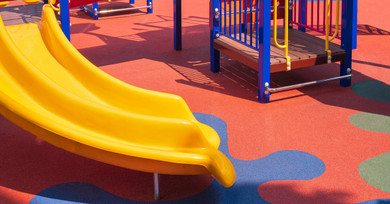Choosing the right playground surface can determine how safe, attractive, and functional your play area becomes over time. Comparing rubber tiles and pour-in-place surfacing helps you understand which option aligns with your budget, maintenance capabilities, and long-term goals.
Both surfaces offer excellent safety and durability, but they differ significantly in installation methods, appearance, and maintenance requirements. Understanding these distinctions allows you to make an informed decision that serves your facility well for years to come.
Installation Process and Timeline
Rubber tiles arrive pre-manufactured and ready to install over a prepared base. Installation teams simply place and connect the tiles according to the layout plan, which typically takes just a few days to complete. This straightforward process minimizes disruption to your facility and allows for quick project completion.
A poured-in-place playground surface requires specialized equipment and trained crews who mix and apply the rubber on-site. The installation process takes longer because crews must carefully layer the base and top coat, then allow for adequate curing time. Weather conditions can delay pour-in-place installations, while tile installation remains largely unaffected by temperature or humidity.
Appearance and Design Flexibility
Pour-in-place surfacing offers unlimited design possibilities with custom colors, patterns, and graphics seamlessly integrated into the surface. Designers can create logos, game markings, and themed elements that become permanent features of the playground. The seamless appearance provides a polished, professional look that many facility managers prefer.
Rubber tiles come in various colors and patterns, but they retain visible seams. Some facilities appreciate the clean, grid-like appearance, while others find the seams less visually appealing. Tiles can create simple patterns through color arrangement, though they cannot replicate the intricate designs possible with poured-in-place options.
Maintenance and Repairs
Rubber tiles simplify repairs because you can replace individual damaged tiles without affecting the surrounding surface. This targeted approach keeps repair costs predictable and allows maintenance staff to handle minor issues independently. Regular cleaning requires sweeping and occasional power washing to remove debris and maintain the tile’s appearance.
Pour-in-place surfaces should be repaired by professionals, since matching the original color and texture takes skill and specialized materials. Their seamless design helps prevent debris buildup more effectively than tiles, but routine cleaning is still important. When properly installed, both surface types offer excellent drainage, though tile systems may need occasional adjustments if the ground settles, creating uneven spots beneath.
Cost Considerations and Value
Initial installation costs for rubber tiles are typically lower than those for pour-in-place surfacing, particularly for smaller projects where equipment mobilization costs matter less. Tile projects also avoid the specialized labor rates associated with pour-in-place installation. However, long-term value depends on your specific situation and priorities.
Pour-in-place surfaces often last longer without requiring component replacement, while tiles may need individual replacements over time. Transportation costs can impact tile pricing for remote locations, whereas pour-in-place crews will bring the materials and equipment regardless of distance.
When comparing rubber tiles and pour-in-place surfacing, consider both the immediate budget constraints and long-term ownership costs to determine which option provides better value for your facility. Contact Discount Playground Supply today to discuss which surfacing solution best meets your playground needs.

